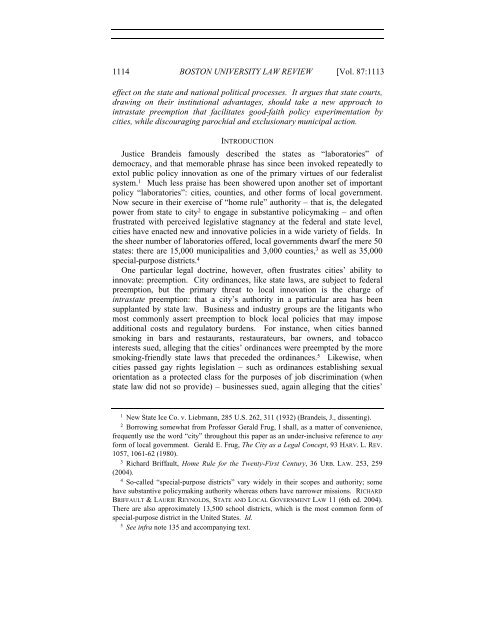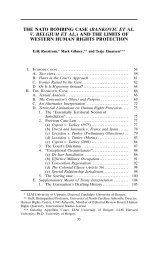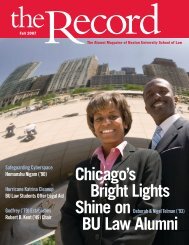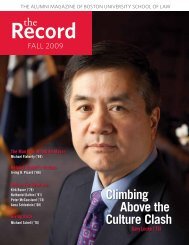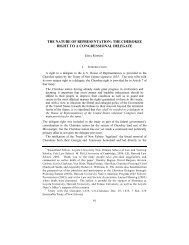1114 BOSTON UNIVERSITY LAW REVIEW [Vol. 87:1113effect on the state and national political processes. It argues that state courts,drawing on their institutional advantages, should take a new approach tointrastate preemption that facilitates good-faith policy experimentation bycities, while discouraging parochial and exclusionary municipal action.INTRODUCTIONJustice Brandeis famously described the states as “laboratories” ofdemocracy, and that memorable phrase has since been invoked repeatedly toextol public policy innovation as one of the primary virtues of our federalistsystem. 1 Much less praise has been showered upon another set of importantpolicy “laboratories”: cities, counties, and other forms of local government.Now secure in their exercise of “home rule” authority – that is, the delegatedpower from state to city 2 to engage in substantive policymaking – and oftenfrustrated with perceived legislative stagnancy at the federal and state level,cities have enacted new and innovative policies in a wide variety of fields. Inthe sheer number of laboratories offered, local governments dwarf the mere 50states: there are 15,000 municipalities and 3,000 counties, 3 as well as 35,000special-purpose districts. 4One particular legal doctrine, however, often frustrates cities’ ability toinnovate: preemption. City ordinances, like state laws, are subject to federalpreemption, but the primary threat to local innovation is the charge ofintrastate preemption: that a city’s authority in a particular area has beensupplanted by state law. Business and industry groups are the litigants whomost commonly assert preemption to block local policies that may imposeadditional costs and regulatory burdens. For instance, when cities bannedsmoking in bars and restaurants, restaurateurs, bar owners, and tobaccointerests sued, alleging that the cities’ ordinances were preempted by the moresmoking-friendly state laws that preceded the ordinances. 5 Likewise, whencities passed gay rights legislation – such as ordinances establishing sexualorientation as a protected class for the purposes of job discrimination (whenstate law did not so provide) – businesses sued, again alleging that the cities’1 New State Ice Co. v. Liebmann, 285 U.S. 262, 311 (1932) (Brandeis, J., dissenting).2 Borrowing somewhat from Professor Gerald Frug, I shall, as a matter of convenience,frequently use the word “city” throughout this paper as an under-inclusive reference to anyform of local government. Gerald E. Frug, The City as a Legal Concept, 93 HARV. L. REV.1057, 1061-62 (1980).3 Richard Briffault, Home Rule for the Twenty-First Century, 36 URB. LAW. 253, 259(2004).4 So-called “special-purpose districts” vary widely in their scopes and authority; somehave substantive policymaking authority whereas others have narrower missions. RICHARDBRIFFAULT & LAURIE REYNOLDS, STATE AND LOCAL GOVERNMENT LAW 11 (6th ed. 2004).There are also approximately 13,500 school districts, which is the most common form ofspecial-purpose district in the United States. Id.5 See infra note 135 and accompanying text.
2007] <strong>INTRASTATE</strong> <strong>PREEMPTION</strong> 1115ordinances had been preempted by state law. 6 The examples are legion, but thestory is familiar: when a city adopts a new policy that differs from state lawand may harm some segment of the business community, a preemptionchallenge is almost certain to follow. 7When a state legislature explicitly declares that local laws are preemptedwithin a certain field – so-called “express preemption” – the courts’ task isrelatively simple: to determine whether the challenged ordinance falls withinthe subject matter that the legislature expressly preempted. 8 But when the state6 See infra note 140 and accompanying text.7 See infra notes 135-47 and accompanying text.8 See Viet D. Dinh, Reassessing the Law of Preemption, 88 GEO. L.J. 2085, 2100 (2000).Of course, even when the legislature expressly preempts an area, courts must still determinethe scope of this express declaration of preemption, a task which involves all of the usualdifficulties of statutory interpretation. See Lars Noah, Reconceptualizing FederalPreemption of Tort Claims as the Government Standards Defense, 37 WM. & MARY L. REV.903, 925-26 (1996); Susan J. Stabile, Preemption of State Law by Federal Law: A Task forCongress or the Courts?, 40 VILL. L. REV. 1, 37-51 (1995). Determining the contours of theexpressly preempted “field” often generates significant disagreement within state courts.See, e.g., Town of Telluride v. Lot Thirty-Four Venture L.L.C., 3 P.3d 30, 32 (Colo. 2000)(disagreeing as to whether a state’s express prohibition on localities adopting rent controlordinances preempts a town’s affordable housing requirement for developers; majority saidyes); Fondessy Enters. v. City of Oregon, 492 N.E.2d 797, 799 (Ohio 1986) (disagreeing asto reach of express preemption provision concerning hazardous waste facilities); DallasMerchant’s & Concessionaire’s Ass’n v. City of Dallas, 852 S.W.2d 489, 490 (Tex. 1993)(disagreeing as to whether state law’s express preemption of the field of alcohol regulationsubsumed a Dallas “zoning” ordinance aimed at problems associated with liquor stores;majority said yes).Further, it is not always clear if and when a provision of state law amounts to an expresspreemption provision. See, e.g., City of Seattle v. Williams, 908 P.2d 359, 366 (Wash.1995) (majority and dissent disagreeing as to whether provision of state law requiring trafficlaws to be “uniform” amounted to an express preemption provision invalidating a localdriving-under-the-influence ordinance that was stricter than state law); see also CalebNelson, Preemption, 86 VA. L. REV. 225, 263 (2000) (“[T]he distinction between ‘express’and ‘implied’ preemption is surprisingly elusive.”). A well-known federal example of theconsiderable disagreement that express preemption cases can generate is Cipollone v.Liggett Group, Inc., 505 U.S. 504 (1992), in which the Court split over the reach of a federalexpress preemption provision.Despite the considerable difficulties express preemption cases may engender, courts insuch cases possess the obvious advantage of being presented with some explicit articulationof the legislature’s intention regarding preemption, whereas implied preemption occurswhen there is legislative silence on the matter. Cf. Daniel A. Farber, State Regulation andthe Dormant Commerce Clause, 3 CONST. COMMENT. 395, 396 n.8 (“Interpreting what [thelegislature] means when it has spoken is often difficult enough; to determine what [thelegislature] means when it has said nothing at all is impossible.”). But see Stabile, supra, at91 (arguing that express preemption does “more mischief than good” and that preemptionshould be the exclusive province of the courts).


